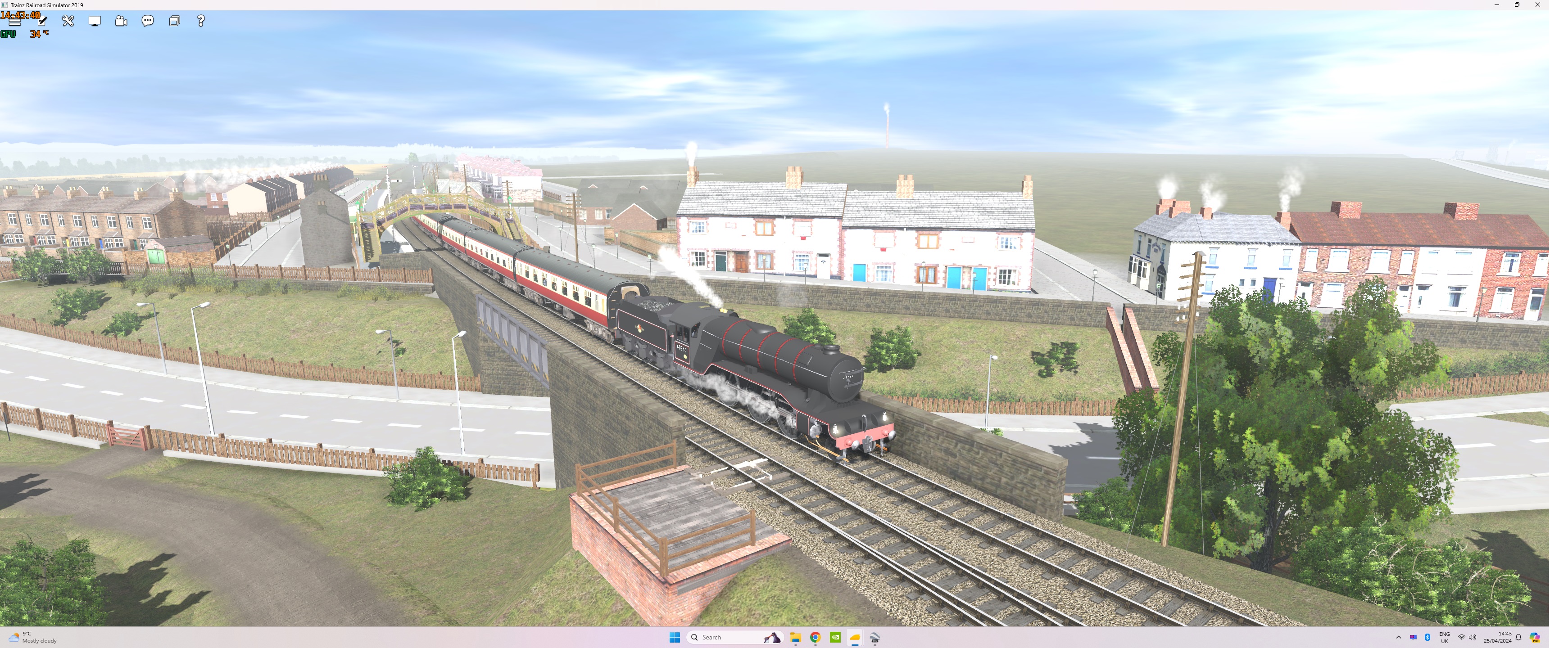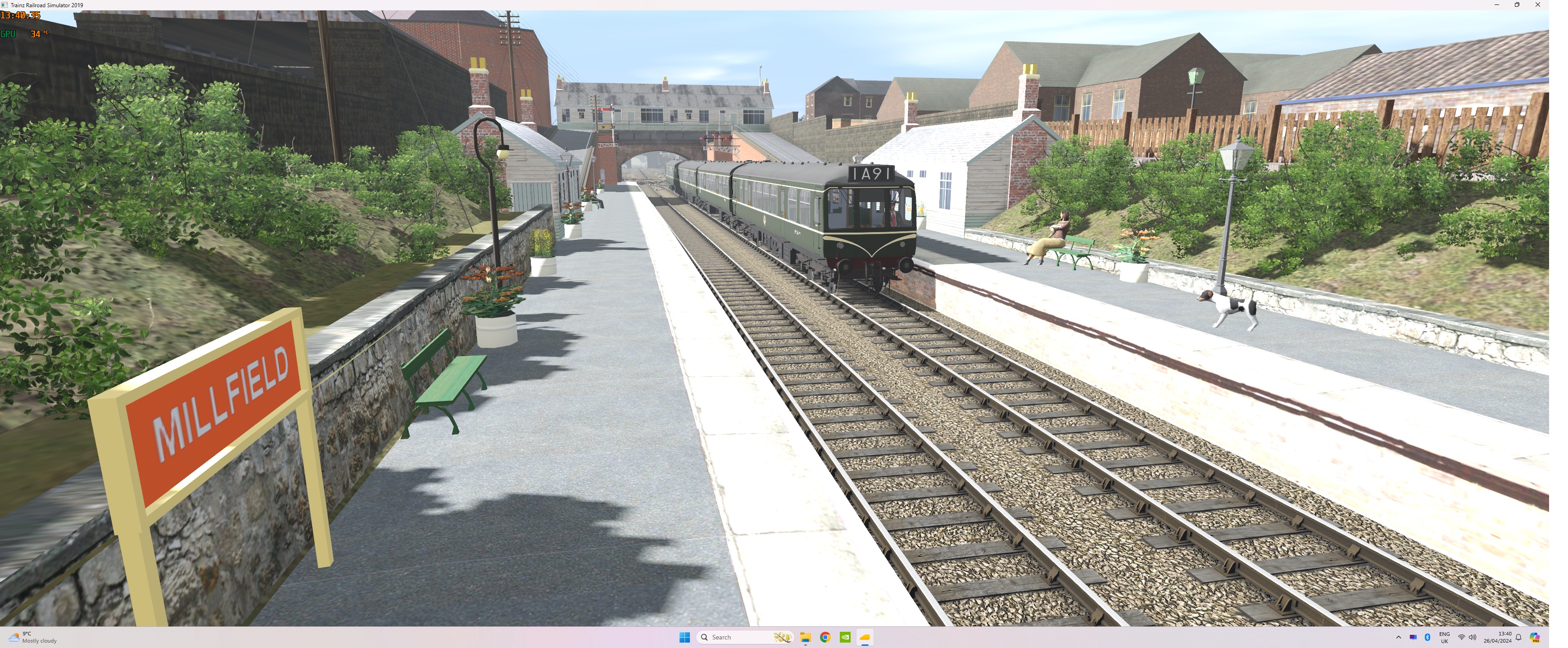Hello Lewisner
You mentioned in an earlier post about getting to grips with a DEM route.
Here is part of my County Durham route, generated in TransDEM, in the vicinity of Ryhope colliery Junction and Ryhope Grange Junction.
A range of screenshots follow from a route in the early days of progress.
There remains an immense amount of work to do here, especially relating to scenery.
A Raven D Class 4-4-4T on the Leeds Northern Up line heading for Ryhope East station.
It is a 3-set of elliptical roof 49ft ordinary bogie carriages with a strenghener added at its head. It is an older arc roof 49 ft ordinary bogie originally built for the North Tyneside passenger service.
In the background a coal train comes off the Ryhope and Silksworth Colliery branch to join the Sunderland and Hartlepool Down line towards Ryhope Grange Junction, bound for Sunderland docks via the Hendon branch.
You can see the high ground in the distance on the left in the vicinity of Silksworth.
A shot looking over the two stations at Ryhope with the D Class heading towards Ryhope East.
Seaton Bank Top can be seen in the background on the Sunderland and Hartlepool line, which was the original NER line between the two towns.
The Raven T2 0-8-0 hauling the coal train taking the Down Sunderland and Hartlepool line.
On the loco's right, on the left side of the screenshot can be seen "the Durham Coast Line", which technically is the NER Leeds Northern branch.
As you can gather, that line started in Leeds, ran up through Ripon and Northallerton, on through Stockton to West Hartlepool.
For administrative purposes the branch ran all the way to Gateshead via Sunderland, Pelaw and Felling.
Between the two lines can be seen the headshunt which is the northern end of the loop and goods lines at Ryhope.
The T2 approaches the southern end of the Ryhope Grange Junction complex, passing over the Down end of the trailing turnout connection.
This move will initially bring the T3 from the Sunderland and Hartlepool Down line on to the Leeds Northern Down line.
Between the two lines is a spur with run around loop.
It has a facing connection from the Up Sunderland and Hartlepool with a trailing connection to the Down Leeds Northern.
My belief is that this allowed a goods or coal train from Sunderland on the Up Leeds Northern to run into the spur alongside the Up Sunderland and Hartlepool, run around it in there and then join the Down Leeds Northern.
from that point it could take either the down Hendon branch or Down Londonderry branch to take it down in to the Sunderland docks complex.
It would not block either of the running lines while the loco changed ends and could also be kept there while higher priority trains passed by.
In the background you can still make out Seaton Bank Top.
As the T2 moves through the Ryhope Grange Junction complex it takes the Down Hendon branch towards Sunderland Docks.
With the growth in weight and length of coal trains you can see that this 600 Ton coal train now technically occupies three branches, the loco on the Down Hendon, the middle of the train on the Down Leeds Northern and the brake van on the Down Sunderland and Hartlepool.
Obviously, nothing can move south along the Leeds Northern in this vicinity at the time of the shot.
Coal trains were not timetabled in the NER, they were booked as required overnight when the mineral department received the day's lifting requirements from the collieries.
Train crew literally did not know when they arrived at work exactly how much work there'd be.
Crews earned a bonus based on the amount of coal they hauled, though they were hostages to timetabled trains.
Paths were reserved in the working timetables but mineral trains were at the bottom of the pecking order operationally, despite being by far and away the biggest revenue generator.
The T2 proceeds along the Down Hendon branch, bound for the docks.
In the foreground runs the Londonderry branch, originally built by the company owned by the 3rd Marquis of Londonderry between Seaham and South Dock, where it had its own passenger terminus.
The NER eventually took it over, using most of it to form the basis of its Durham Coastal Line, with construction commencing in 1899.
The coastal line was officially the Leeds Northern branch.
I don't usually post shots with little or no scenery present, so my apolgies for that, but Lewisner, this gives you an idea of what the terrain looks like on the DEM.
V2 at Seaton Bank Head 24.04.24 by A1 Northeastern, on Flickr




















